Catch-22 第二十二条军规
- 格式:ppt
- 大小:447.50 KB
- 文档页数:20
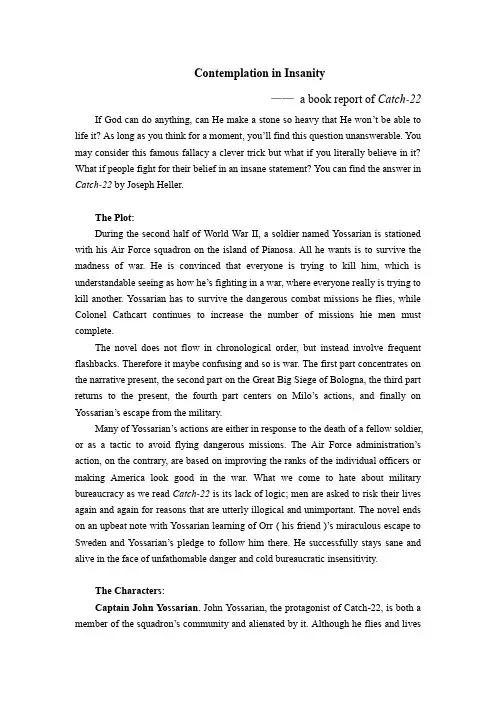
Contemplation in Insanity——a book report of Catch-22 If God can do anything, can He make a stone so heavy that He won’t be able to life it? As long as you think for a moment, you’ll find this question unanswerable. You may consider this famous fallacy a clever trick but what if you literally believe in it? What if people fight for their belief in an insane statement? You can find the answer in Catch-22 by Joseph Heller.The Plot:During the second half of World War II, a soldier named Yossarian is stationed with his Air Force squadron on the island of Pianosa. All he wants is to survive the madness of war. He is convinced that everyone is trying to kill him, which is understandable seeing as how he’s fighting in a war, where everyone really is trying to kill another. Yossarian has to survive the dangerous combat missions he flies, while Colonel Cathcart continues to increase the number of missions hie men must complete.The novel does not flow in chronological order, but instead involve frequent flashbacks. Therefore it maybe confusing and so is war. The first part concentrates on the narrative present, the second part on the Great Big Siege of Bologna, the third part returns to the present, the fourth part centers on Milo’s actions, and finally on Yossarian’s escape from the military.Many of Yossarian’s actions are either in response to the death of a fellow soldier, or as a tactic to avoid flying dangerous missions. The Air Force administration’s action, on the contrary, are based on improving the ranks of the individual officers or making America look good in the war. What we come to hate about military bureaucracy as we read Catch-22 is its lack of logic; men are asked to risk their lives again and again for reasons that are utterly illogical and unimportant. The novel ends on an upbeat note with Yossarian learning of Orr ( his friend )’s miraculous escape to Sweden and Yossarian’s pledge to follow him there. He successfully stays sane and alive in the face of unfathomable danger and cold bureaucratic insensitivity.The Characters:Captain John Yossarian. John Yossarian, the protagonist of Catch-22, is both a member of the squadron’s community and alienated by it. Although he flies and liveswith the men, he is marked as an outsider by the fact that many of the men think he is insane. But Yossarian’s characteristics are not those of a typical hero. He does not risk his life to save others; in fact, his primary goal throughout the novel is to avoid risking his life whenever possible. Maybe it is because that the system of values around Yossarian is so skewed that this approach seems to be the only truly moral stance he can take, if only because it is so logical. In a world where life itself is so undervalued and so casually lost, it is possible to redefine heroism as simple self-preservation. In the end, when offered a choice between his own safety and the safety of the entire squadron, Yossarian is unable to choose himself over others. This concern for others complicates the simple logic of self-preservation, and creates its own Catch-22: life is not worth living without a moral concern for the well-being of others, but a moral concern for the well-being of others endangers one’s life.Milo Minderbinder.Representing an extreme version of capitalist free enterprise that has spiraled out of control, Milo seems simultaneously brilliant and insane. What starts out as a business in black-market eggs turns into a worldwide enterprise in which, he claims, “everyone has a share.” He lies, cheats and steals his way through the war. The Germans pay him to bomb his own base and the Americans pay him to bomb Germans. He uses military planes to fly his goods from place to place, and lives in palaces. Milo tells the men in his squadron that they all have a share of his profits, but he bombs his own squadron as part of a deal he has made with the Germans. His willingness to allow his own camp to be bombed shows his complete disregard for the sides drawn by the war, and the men’ s acceptance of payment for being bombed shows that Milo is not alone in placing a high value on making money.The Themes and Ideas:Catch-22.There’s only one catch to Yossarian’s plan to save himself, and that’s Catch-22. This passage from Chapter 5 marks the novel’s first mention of the paradoxical law called “Catch-22.”There was only one catch and that was Catch-22, which specified that a concern for one’s own safety in the face of dangers that were real and immediate was the process of a rational mind. Orr was crazy and could be grounded. All he had to do was ask; and as soon as he did, he would no longer be crazy and would have to fly more missions. Orr would be crazy to fly more missions and sane if he didn’t, but if he wassane he would have to fly them. If he flew them he was crazy and didn’t have to; but if he didn't want to he was sane and had to. Yossarian was moved very deeply by the absolute simplicity of this clause of Catch-22 and let out a respectful whistle.“That’s some catch, that Catch-22,” he observed.“It’s the best there is,” Doc Daneeka agreed.The more Yossarian learns about Catch-22, though, the bigger it grows, each new clause as infuriating and paradoxical as the last. Catch-22, we learn, is the Bible of bureaucracy — every pointless and petty regulation made by someone who has never seen a battlefield to make themselves look good with no sleep lost for the people like Yossarian who get killed in the process.There’s no reasoning or arguing with Catch-22. It’s not personal. It’s just the rules, and if the rules say that Yossarian has to die, then that’s what Yossarian has to do.Over the course of the novel, Catch-22 is described in a number of different ways that can be applied to a number of different aspects of wartime life; here, however, Catch-22 affects Yossarian most specifically. Catch-22 is alarmingly persuasive; even Yossarian accepts what seems to be its logical infallibility. But Catch-22 is an abstract thing; we find out later that Yossarian believes that Catch-22 does not really exist. It is a trap made up of words, and words are faulty things, often misrepresenting reality. What is so upsetting about the way Catch-22 is applied throughout the novel is that real men are sent into real peril based on a few unreal and unreliable words. The the pointlessness of the fact makes Yossarian crazy.Personality in the insane world.Unlike other anti-romantic war novels, Catch-22relies heavily on humor to convey the insanity of war, presenting the horrible meaninglessness of armed conflict through a kind of desperate absurdity rather than through graphic depictions of suffering and violence. Catch-22also distinguishes itself from other anti-romantic war novels through its core values: the story of Yossarian, the protagonist, is ultimately not one of despair but one of hope. He believes that the positive urge to live and to be free can redeem the individual from the dehumanizing machinery of war. The novel is told as a series of loosely related, tangential stories in no particular chronological order. The narrative that emerges from this structural tangle upholds the value of the individual in the face of the impersonal, collective military mass; at every stage it mocks insincerity and hypocrisy, even when such values appear triumphant.Despite its World War II setting, Catch-22is often thought of as a signaturenovel of the 1960s and 1970s. It was during those decades that American youth truly began to question authority. Hippies, university protests, and the civil rights movement all marked the 1960s as a decade of revolution, and Heller’s novel fit in perfectly with the spirit of the times. In fact, Heller once said, “I wasn’t interested in the war in Catch-22. I was interested in the personal relationships in bureaucratic authority.” Whether Heller was using the war to comment on authority or using bureaucracy as a statement about the war, it is clear that Catch-22 is more than just a war novel. It is also a novel about the moral choices that every person must make when faced with a system of authority whose rules are both immoral and illogical. This reminds me the dark ten years of the Great Proletarian Cultural Revolution. Millions of people were persecuted and suffered a wide range of abuses and millions of people became insane illogical, which makes the perseverance of personal principles more valuable and remarkable.Reference:[1]约瑟夫·海勒.第二十二条军规[M].南京: 译林出版社.[2]常文革.黑色幽默的典范[N].长春师范学院学报,2005-9。
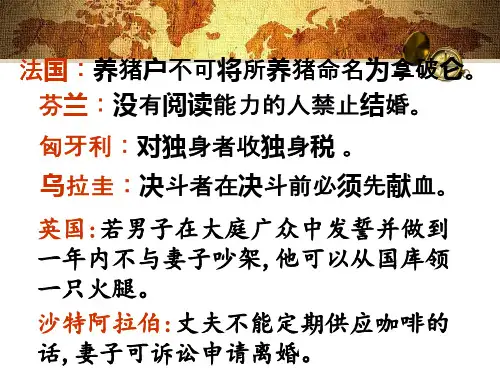

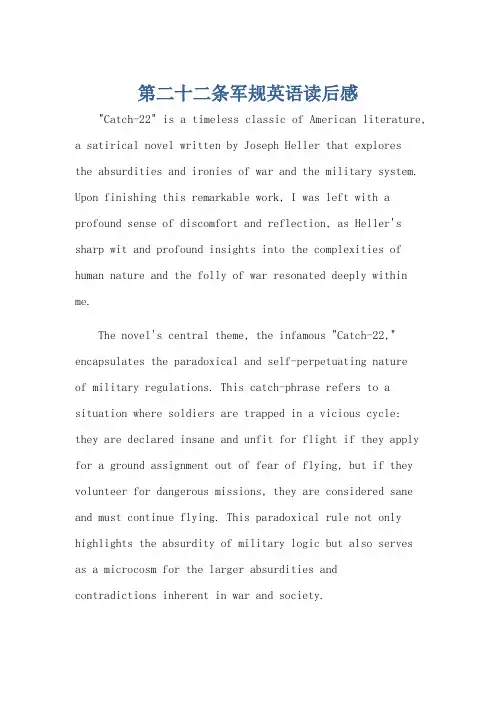
第二十二条军规英语读后感"Catch-22" is a timeless classic of American literature, a satirical novel written by Joseph Heller that exploresthe absurdities and ironies of war and the military system. Upon finishing this remarkable work, I was left with a profound sense of discomfort and reflection, as Heller's sharp wit and profound insights into the complexities of human nature and the folly of war resonated deeply within me.The novel's central theme, the infamous "Catch-22," encapsulates the paradoxical and self-perpetuating natureof military regulations. This catch-phrase refers to a situation where soldiers are trapped in a vicious cycle: they are declared insane and unfit for flight if they apply for a ground assignment out of fear of flying, but if they volunteer for dangerous missions, they are considered sane and must continue flying. This paradoxical rule not only highlights the absurdity of military logic but also serves as a microcosm for the larger absurdities andcontradictions inherent in war and society.The characters in "Catch-22" are a testament toHeller's keen observation of human behavior and psychology. Each character is a complex, multi-faceted individual, with their own unique quirks, flaws, and dreams. The protagonist, Yossarian, is a relatable figure who struggles to navigate the insanity of war while trying to preserve his sanity and humanity. His interactions with the other characters, such as the cynical Milo Minderbinder and the eccentric Doc Daneeka, reveal the diverse range of human responses to the stress and chaos of war.What makes "Catch-22" particularly powerful is itsability to transcend the specific context of the Second World War and speak to the universal themes of humanity, power, and morality. Heller's satire is not limited to the military but extends to society at large, exposing thefolly and hypocrisy that can exist in any system wherepower and authority are unchecked.The novel's writing style is also noteworthy. Heller's use of humor and irony to expose the absurdities of war is both brilliant and effective. His narratives are often chaotic and disjointed, reflecting the confusion and chaosof war itself. The language is both colloquial and poetic, with Heller's unique voice shining through in every sentence.Reading "Catch-22" has been a deeply enriching experience for me. It has not only expanded my understanding of war and the military but has also challenged my views on society and human nature. Heller's satire forces us to question the values and assumptions that underlie our world, making us more aware of the potential absurdities and ironies that can exist in even the most seemingly rational systems.In conclusion, "Catch-22" is a must-read for anyone interested in exploring the complexities of human nature and the folly of war. It is a thought-provoking and insightful novel that will leave you with a newfound appreciation for the subtleties and paradoxes of life. Heller's masterful blend of humor, irony, and profound social commentary makes "Catch-22" a timeless classic that will continue to resonate with readers for generations to come.。
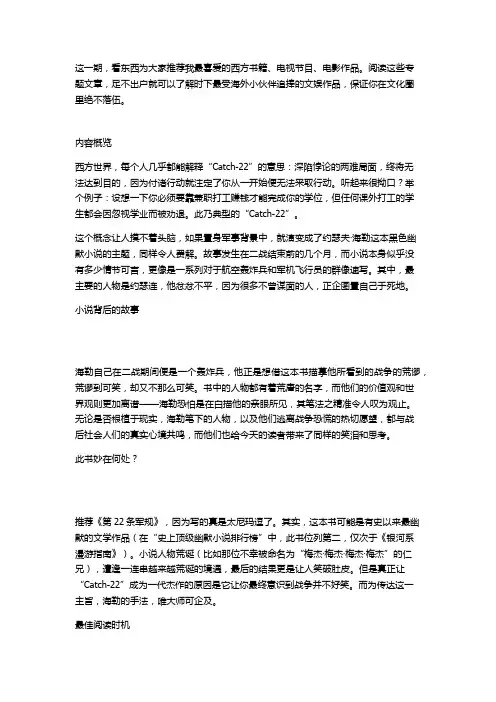
这一期,看东西为大家推荐我最喜爱的西方书籍、电视节目、电影作品。
阅读这些专题文章,足不出户就可以了解时下最受海外小伙伴追捧的文娱作品,保证你在文化圈里绝不落伍。
内容概览西方世界,每个人几乎都能解释“Catch-22”的意思:深陷悖论的两难局面,终将无法达到目的,因为付诸行动就注定了你从一开始便无法采取行动。
听起来很拗口?举个例子:设想一下你必须要靠兼职打工赚钱才能完成你的学位,但任何课外打工的学生都会因忽视学业而被劝退。
此乃典型的“Catch-22”。
这个概念让人摸不着头脑,如果置身军事背景中,就演变成了约瑟夫·海勒这本黑色幽默小说的主题,同样令人费解。
故事发生在二战结束前的几个月,而小说本身似乎没有多少情节可言,更像是一系列对于航空轰炸兵和军机飞行员的群像速写。
其中,最主要的人物是约瑟连,他忿忿不平,因为很多不曾谋面的人,正企图置自己于死地。
小说背后的故事海勒自己在二战期间便是一个轰炸兵,他正是想借这本书描摹他所看到的战争的荒谬,荒谬到可笑,却又不那么可笑。
书中的人物都有着荒唐的名字,而他们的价值观和世界观则更加离谱——海勒恐怕是在白描他的亲眼所见,其笔法之精准令人叹为观止。
无论是否根植于现实,海勒笔下的人物,以及他们逃离战争恐慌的热切愿望,都与战后社会人们的真实心境共鸣,而他们也给今天的读者带来了同样的笑泪和思考。
此书妙在何处?推荐《第22条军规》,因为写的真是太尼玛逗了。
其实,这本书可能是有史以来最幽默的文学作品(在“史上顶级幽默小说排行榜”中,此书位列第二,仅次于《银河系漫游指南》)。
小说人物荒诞(比如那位不幸被命名为“梅杰·梅杰·梅杰·梅杰”的仁兄),遭逢一连串越来越荒诞的境遇,最后的结果更是让人笑破肚皮。
但是真正让“Catch-22”成为一代杰作的原因是它让你最终意识到战争并不好笑。
而为传达这一主旨,海勒的手法,唯大师可企及。
最佳阅读时机因为这部小说太长(500多页),所以正好等放假再看。
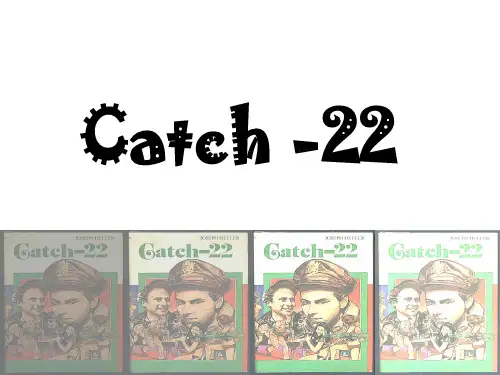
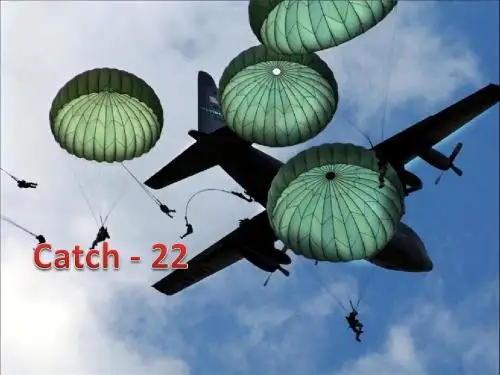
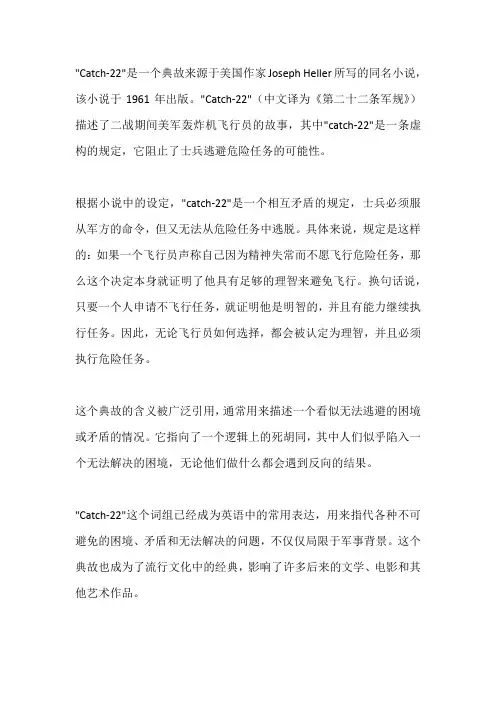
"Catch-22"是一个典故来源于美国作家Joseph Heller所写的同名小说,该小说于1961年出版。
"Catch-22"(中文译为《第二十二条军规》)描述了二战期间美军轰炸机飞行员的故事,其中"catch-22"是一条虚构的规定,它阻止了士兵逃避危险任务的可能性。
根据小说中的设定,"catch-22"是一个相互矛盾的规定,士兵必须服从军方的命令,但又无法从危险任务中逃脱。
具体来说,规定是这样的:如果一个飞行员声称自己因为精神失常而不愿飞行危险任务,那么这个决定本身就证明了他具有足够的理智来避免飞行。
换句话说,只要一个人申请不飞行任务,就证明他是明智的,并且有能力继续执行任务。
因此,无论飞行员如何选择,都会被认定为理智,并且必须执行危险任务。
这个典故的含义被广泛引用,通常用来描述一个看似无法逃避的困境或矛盾的情况。
它指向了一个逻辑上的死胡同,其中人们似乎陷入一个无法解决的困境,无论他们做什么都会遇到反向的结果。
"Catch-22"这个词组已经成为英语中的常用表达,用来指代各种不可避免的困境、矛盾和无法解决的问题,不仅仅局限于军事背景。
这个典故也成为了流行文化中的经典,影响了许多后来的文学、电影和其他艺术作品。
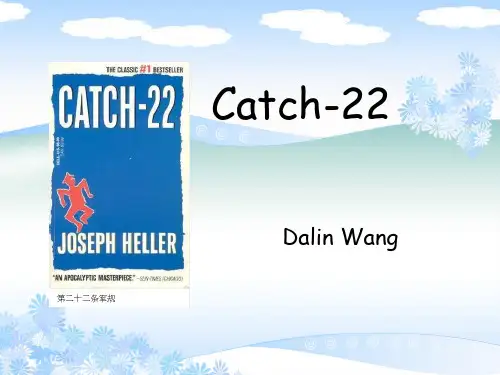
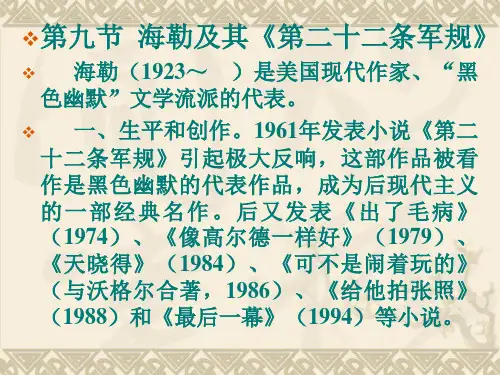
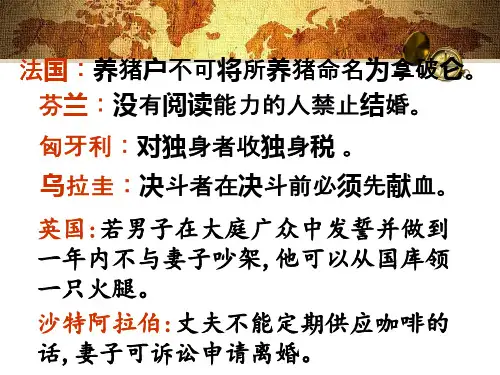
海勒《第二十二条军规》主要内容概要及赏析(最新版)编制人:__________________审核人:__________________审批人:__________________编制单位:__________________编制时间:____年____月____日序言下载提示:该文档是本店铺精心编制而成的,希望大家下载后,能够帮助大家解决实际问题。
文档下载后可定制修改,请根据实际需要进行调整和使用,谢谢!并且,本店铺为大家提供各种类型的经典范文,如诗歌散文、原文赏析、读书笔记、经典名著、古典文学、网络文学、经典语录、童话故事、心得体会、其他范文等等,想了解不同范文格式和写法,敬请关注!Download tips: This document is carefully compiled by this editor.I hope that after you download it, it can help you solve practical problems. The document can be customized and modified after downloading, please adjust and use it according to actual needs, thank you!In addition, this shop provides you with various types of classic sample essays, such as poetry and prose, original text appreciation, reading notes, classic works, classical literature, online literature, classic quotations, fairy tales, experience, other sample essays, etc. if you want to know the difference Please pay attention to the format and writing of the sample essay!海勒《第二十二条军规》主要内容概要及赏析【导语】:《第二十二条军规》外国文学作品简析作者:[美]海勒类型:小说背景搜索本书成书于1961年,是美国黑色幽默文学的代表作。